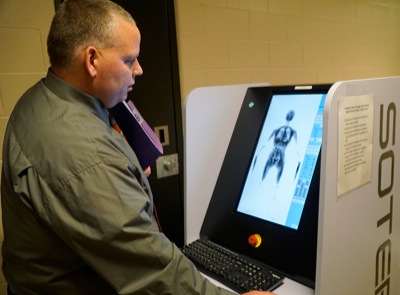Tuesday, January 2nd, 2018
Body scanner: high-tech search for contraband
By William Kincaid

Photo by William Kincaid/The Daily Standard
Mercer County Sheriff's Corrections Capt. Martin Emerine conducts a sample test on the jail's new full-body security scanner used to detect contraband hidden inside or upon people entering the county jail.
CELINA -Before being processed through intake at the Mercer County jail, all incoming inmates are screened for contraband hidden inside or upon them with a new full-body scanner that debuted on Nov. 22.
County commissioners last year approved sheriff Jeff Grey's request to purchase the system for $118,750 plus an extended warranty for $43,750, bringing the total cost to $162,500. Commissioners chose to purchase the unit from OD Security North America of Daniel Island.
Grey in late July had pitched the proposal to commissioners, explaining that as more drugs are making their way into the jail, it was time to follow the lead of other state correctional facilities and acquire a body scanner.
A body scanner won't completely stanch the flow of illicit substances into the jail due to criminals' ingenuity, he had said. Yet, the unit, similar to low-level radiation units used to scan airline passengers, will help jail personnel detect drugs and may deter inmates from trying to take them in.
Drugs can make their way into the jail when people are booked or when inmates return from a work-release program or medical furlough.
OD Security North America delivered, installed and calibrated the machine in November. Since its installation, the machine has been used 186 times, including test runs, sheriff's capt. Martin Emerine told the newspaper. The jail, according to Grey, books about 1,200 inmates a year.
Emerine, chief corrections officer Jodie Lange and 15 other corrections personnel were all trained for half a day to use the scanner.
"We had some classroom time and then we had some hands-on time with it," Lange said, noting the body scan itself lasts about 8 seconds.
Personnel are still weighing whether to assign body-scanning duties to a few corrections officers or to the entire staff. Now, anyone on duty runs the body scanner on an incoming inmate.
Inmates are asked to stand facing away from the scanner as it makes an image of their fully clothed bodies. The machine can detect both metal and non-metallic objects including drugs, drug paraphernalia, small firearms, blades, explosive devices or cellphones.
Before they are scanned, though, people are asked if they have anything on their persons that isn't permitted inside the jail.,
"It is a (felony) crime to convey something into the detention facility, and we'll charge them," Grey said.
However, if, for example, people confess to possessing heroin before being scanned, they would be charged with heroin possession but not conveyance into a detention facility, Grey noted.
"I really think that the more we use it … at least the people that come to our jail frequently, we'll find less and less stuff because they'll know we have the body scanner," Grey said.
Incoming inmates are not permitted into intake, where they're formally booked into the facility, until scanned in a corridor connected to the jail's sallyport or entryway. If they refuse to comply, they're placed in a holding area until they decide to cooperate, Emerine said. Some people, though, including those undergoing chemotherapy or radiation, pregnant or bound to a wheelchair, are not scanned but are placed in a special holding area.
After the scan is complete, the corrections officer reviews the body image, carefully searching for what looks like tissue displacement or a halo around a certain area. For instance, bags of drugs would show up as dark blobs in an image of a person's intestines.
"It's not like it has a beacon," Emerine said, explaining it's up to the corrections officer to find the clues and determine if the person is indeed carrying contraband, an ability that improves upon practice.
If corrections officers think they have spotted something, they'll then ask the person to remove the item or begin the search warrant process.
"If you come to jail and we run you through the body scanner and we see something that we think is contraband, if we're going to take you to the hospital to have them remove it, we still have to get a search warrant," Grey said.
So far, corrections officers have been able to find contraband on two incoming inmates, Grey said.
"We had one lady who the (Heroin Interdiction Team) got and they were going to bring her to jail, and when she found out we had a body scanner, she went, 'I swallowed it,' " Grey said.
What she swallowed was a baggie of crack cocaine, Grey said. The woman was taken to the hospital and later indicted for drug possession.

